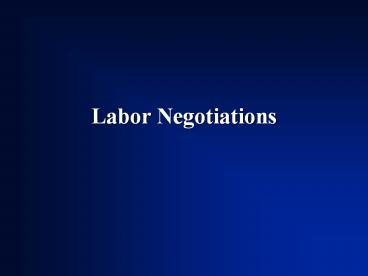Labor Negotiations PowerPoint PPT Presentation
1 / 11
Title: Labor Negotiations
1
Labor Negotiations
2
Labor Negotiations
- Contract expires this year.
- Labor will produce a set of demands.
- 10 above current contract.
- Management will establish negotiation range based
on current contract . - Current Wages 80 ltxlt150
- Benefits, Profit Sharing and Annual Raises 0
ltxlt150
3
Labor Position
- Labor demands 10 over current contract.
Current Contract
11.00
10.00
4
Management Position
- Enter Starting position with one bids (wages,
benefits, profit sharing, and annual wage
increase) to Labor - First bid has to be within the parameters (wages
80 and 150, other between 0 and 150) - Negotiation ceiling is automatically 10 higher
than starting position.
Firm 1
Firm 2
Firm 3
Labor
8.00
11.50
12.00
11.00
First Bid
11.00
10.00
8.00
12.00
11.50
5
Negotiation
- Labor looks at only the first bid made by
management and selects the best bid over 10 of
current contract this becomes labors new demand.
Firm 1
Firm 2
Firm 3
Labor
8.00
11.50
12.00
12.00
First Bid
Settle Firm 3
Labor
10.00
8.00
12.00
11.50
6
Negotiation
- Labor looks at the remaining negotiating ceilings
by the firms not offering the best first bid.
Firm 1
Firm 2
Labor
8.00
11.50
12.00
First Bid
8.80
12.50
Second Bid
Labor
10.00
8.00
12.00
11.50
8.80
12.50
7
Negotiation
- If the negotiating ceiling is higher than labors
demand, labor will settle for half the difference
between first bid and labors demand. No strike
will occur.
Firm 1
Firm 2
Labor
8.00
11.50
12.00
First Bid
8.80
12.50
Second Bid
11.75
Settle
Settle Firm 2
Labor
10.00
8.00
12.00
11.50
12.50
8.80
8
Negotiation
- If the negotiating ceiling is lower than the
labors demand. Settlement is half way between
labors demand and the negotiating ceiling,
resulting in a strike.
Firm 1
Labor
8.00
12.00
First Bid
8.80
Second Bid
10.40
Settle
Settle Firm 1
Labor
10.00
8.00
12.00
8.80
9
Length of Strike
- For every 1 difference in wages, 1 week strike.
- For every 300 difference in benefits, 1 week
strike. - Each difference in profit sharing and annual
wage increase, 1 week strike. - Max length of strike 12 weeks.
10
- Strikes always occur at the end of the year.
- If a strike is 21 days long, workers would
picket during the last three weeks in December. - If you have inventory on hand during the
strike, sales continue. RD projects also
continue.
11
Tactics
- Your company will need to determine which
negotiation tactics best serves your purposes. - Companies with low automation will want to
control labor costs. They would offer the lowest
acceptable wage, which is 80 of the current
contract and eliminate all benefits. - Companies with high automation might choose to be
extremely generous with their workers, which will
impose higher costs on their competitors
(Remember, Labor looks at all offers and makes
the highest offer part of their demand).

